April showers could change wheat disease outlook
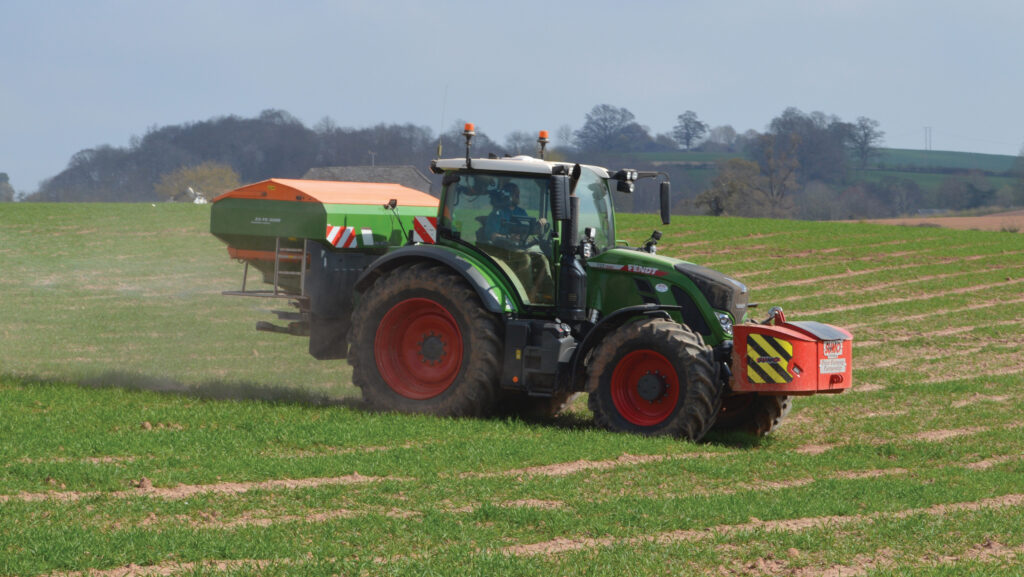 © David Jones
© David Jones Winter wheat growers are being urged to be wary of septoria and yellow rust if the weather turns wet leading up to key T1 fungicide spray timings at the end of this month.
Disease pressure in wheat is seen as moderate 1to low in the current dry weather, but these two diseases, as well as brown rust, eyespot and mildew, could develop quickly with a change in the weather.
Farmers Weekly joined a Bayer-organised Crop Doctor tour taking in Herefordshire, North Yorkshire and north-west Norfolk to assess the disease risk in wheat crops for this season.
West
Septoria is lurking on the lower leaves of winter wheat crops in Herefordshire despite the driest March for more than 50 years, which has held back the rapid spread of the damaging, wet-loving disease.
Wheat crops at Callow, just south of Hereford, on the Crop Doctor trial site were showing signs of septoria on older leaves and the odd spot of mildew, while elsewhere in the county yellow rust has been seen on the susceptible variety Zyatt.
See also: Early-drilling could see rise in spring barley net blotch
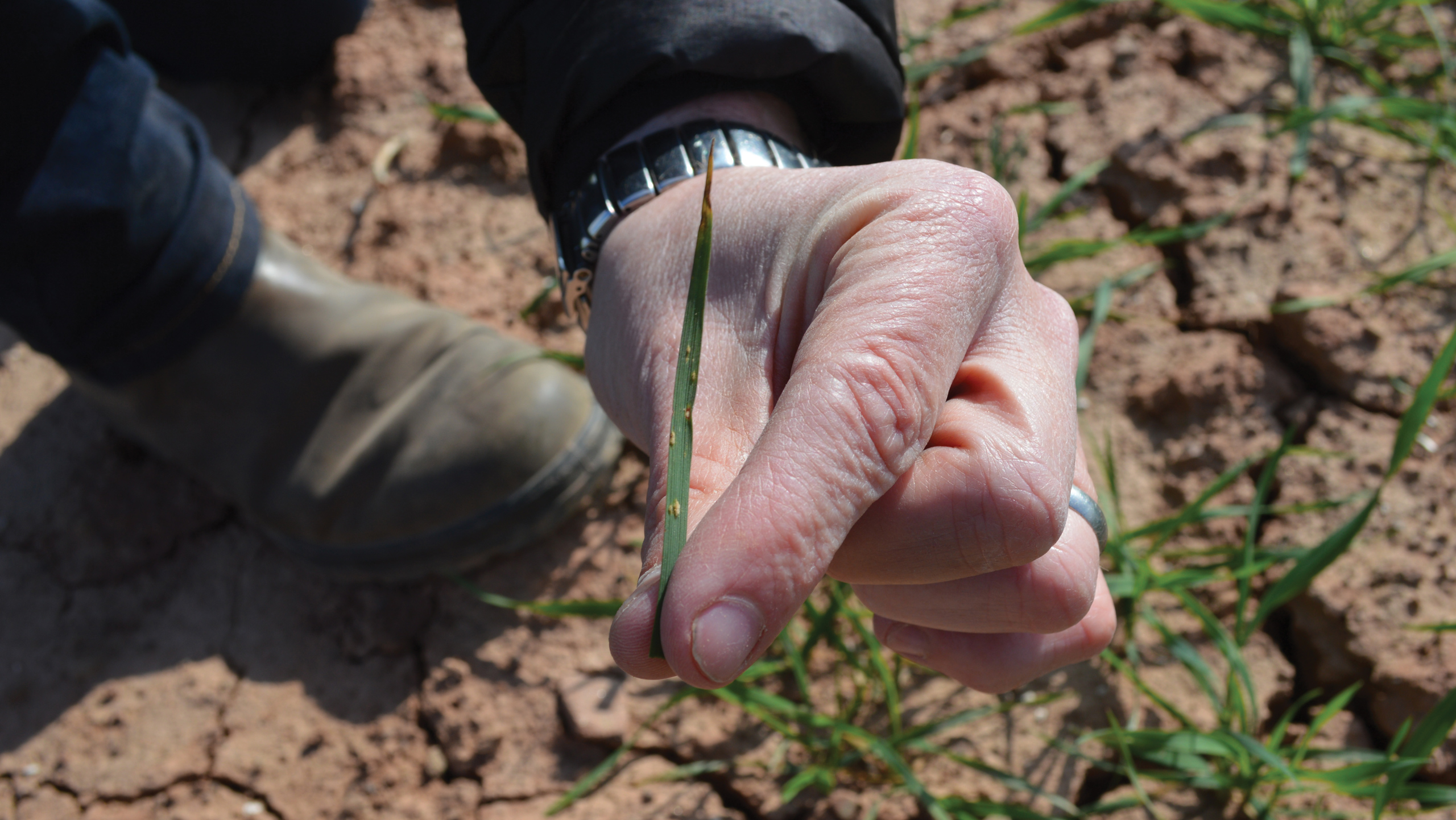
© David Jones
Chloe Francis, plant pathologist with crop consultant Adas, says those growing wheat varieties with good rust resistance could well have saved on an early T0 spray, but should be considering a broad spectrum T1.
“Crops are a bit backward and patchy after a difficult, wet autumn, but although they look generally clean, you can still find septoria on the lower leaves,” she says.
A T0 spray aimed at protecting leaf four, and applied in late March/early April, is largely targeted at rust diseases, leaving effective septoria control for later.
Gareth Bubb, Bayer’s commercial technical manager covering the west of England including Herefordshire, says the decision on T0s should be largely based on variety choice, and rust-susceptible ones can be treated with an azole or a strobilurin.
He favours a rust-active azole such as tebuconazole or prothioconazole rather than a strobilurin at this stage, as strobilurins can be used only twice in a season and so could be held in reserve for later in the season.
He suggests strobilurins should only be considered for use at T0 in a bad brown rust season.
Herefordshire has had its wettest autumn and winter from September to February for a number of years, like many other areas of the country, and then saw a very dry March with a mere 6mm of rain.
Only a limited area of wheat was drilled early because of rain, forcing many to delay, and the Crop Doctor site at Monkhall Farm, Callow, was drilled on 13 November into heavy clay loam soils.
England and Wales saw the driest March since 1961, holding back septoria spread, while cool, dry conditions with cold nights have also restricted yellow rust and brown rust development.
A repeat of last year’s early outbreak of brown rust – due to 2024’s mild and wet early spring – is seen as unlikely.

© David Jones
Looking ahead to T1s, which in Herefordshire largely occur around 25 April, Chloe suggests growers’ focus should be mainly on septoria, with a careful eye kept on yellow rust, and also the risks of brown rust and eyespot.
“Growers should take a broad-spectrum approach, but primarily look at the septoria risk with rainfall levels from late April to the beginning of June driving septoria infection levels,” she says.
Gareth also favours the broad-spectrum approach at T1. “We are looking for a clean crop as we come up to the next T2 timing in May,” he says.
He has conducted DNA tests under Bayer’s Crop Check scheme to look at disease levels, and leaf samples taken in late March showed low levels of septoria in varieties such as Dawsum, Skyscraper, Skyfall and Zyatt.
However, in the fast-developing variety Extase, latent septoria levels were higher, indicating that treatment would soon be necessary.
Low level of yellow rust were detected in the DNA test, with the susceptible Skyfall showing the highest.
Many agronomists expect broad-spectrum products to be used at T1 such as Ibon-based mixes, Ascra and Revystar, while more focused septoria products such as Miravis Plus and Univoq may be aimed more at the T2 flag leaf stage.
Key wheat fungicide actives
- Ascra SDHIs bixafen and fluopyram plus azole prothioconazole
- Arizona Multisite protectant folpet
- Comet Strobilurin pyraclostrobin
- Miravis Plus SDHI pydiflumetofen (Adepidyn), in a twin pack with azole prothioconazole (Era)
- Plaxium SDHIs isoflucypram (Iblon) and fluopyram, plus azole prothioconazole
- Revystar SDHI fluxapyroxad (Xemium) plus azole mefentrifluconazole (Revysol)
- Univoq Picolinamide fenpicoxamid (Inatreq) plus azole prothioconazole
- Vimoy SDHI isoflucypram (Iblon), in a twin pack with azole prothioconazole (Proline)
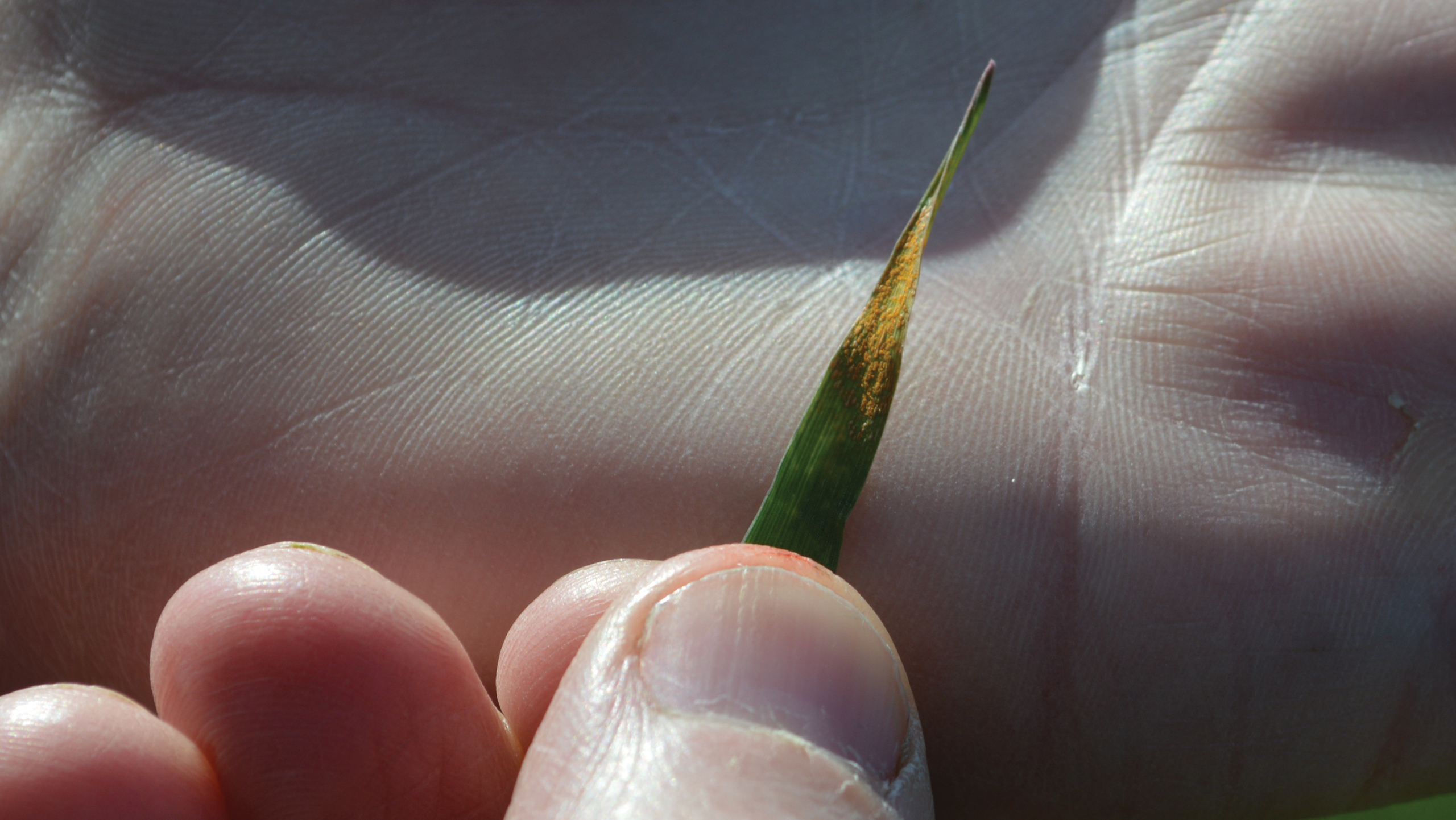
Early signs of yellow rust © David Jones
North
Yellow rust was clearly visible in susceptible winter wheat varieties in North Yorkshire in cool and moist conditions near the River Ouse, emphasising the need to leave no “disease gaps” in a T1 fungicide spray later this month.
With septoria also bubbling away on the older leaves on the site at the Stockbridge Technology Centre, Cawood, near Selby, the need will be to make sure a fungicide programme protects against these two damaging diseases
Fiona Burnett, professor of applied plant pathology at Scotland’s Rural College (SRUC), saw some signs of yellow rust in susceptible wheat varieties Skyfall and Zyatt on the site, and reminded growers that yellow rust is the driver behind early fungicide sprays.
“If there is a gap in the fungicide armoury then you are likely to see yellow rust first as it can cycle twice as fast as septoria,” she says.
Fiona points out that yellow rust can cycle in temperatures as low as 3C, and the cool and moist conditions at the site, with early morning dew on the crop, was conducive to the development and spread of the disease.
“The current low disease pressure is a good position to be in, but the dew will keep septoria and yellow rust ticking away,” she says.
The North Yorkshire Crop Doctor trial site was drilled on 5 October into medium loamy clay soils, in an area where yellow rust can be a problem due to the proximity of the river as well as the constant threat of septoria.
The site was too far north to see the severe brown rust disease problems seen further south last year.
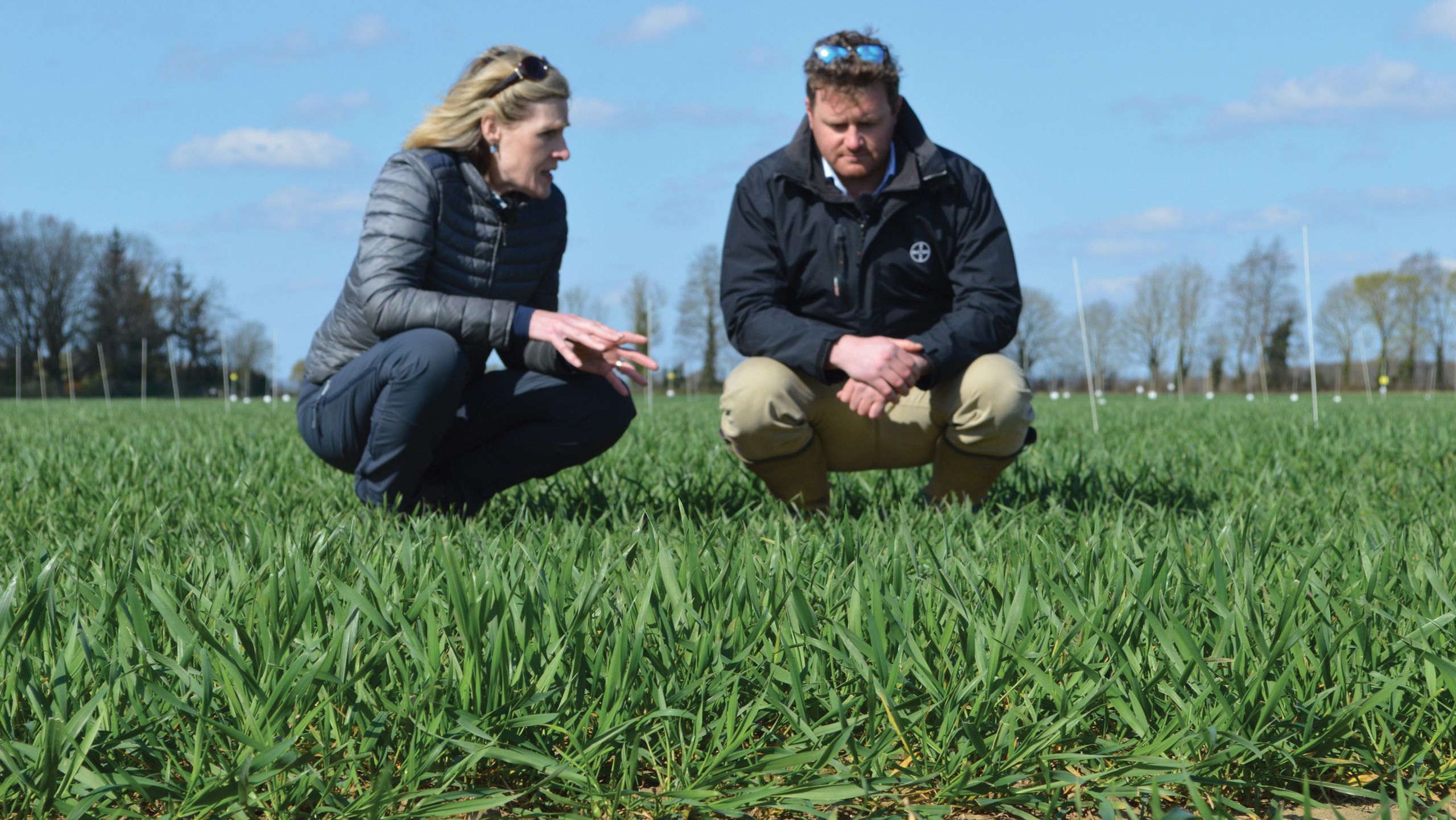
Fiona Burnett of SRUC, left, and Tom Sorely of Bayer © David Jones
Fiona says a T0 spray should not be seen as ubiquitous and should be applied only when spots of yellow rust are seen. But she did point out that missing out a T0 does make the timing of a T1 spray in late April more critical.
She favours an azole/strobilurin mix, if a T0 is needed to utilise different chemistries and guard against disease resistance building up against fungicides, and suggests a tebuconazole/pyraclostrobin approach to give both good knockdown and persistence.
The strategy towards a T1 spray should be based on how successful a T0 (if applied) has been and assessing the disease pressure from such factors as variety choice, drilling date and weather conditions.
“The T1 should be aimed at septoria, yellow rust and eyespot, with brown rust unlikely to be serious this far north,” she says.
This means a two-active-ingredient approach such as an SDHI-azole mix, or using an Inatreq-azole mix, plus she favours the use of a multisite fungicide at T1 and T2, such as folpet, to give good protection from diseases.
Most SDHI-azole or Inatreq-azole mixes will target septoria, while most SDHIs and the azole prothioconazole have good activity against eyespot. If rust is a problem and no T0 was applied, the T1 could be bolstered by a strobilurin, she suggests.
Tom Sowerby, Bayer’s technical commercial manager for Yorkshire, notes that the site had seen cold weather throughout January and February, while March had turned very dry, like much of the rest of the country.
“Septoria is the main disease threat at the site and it is bubbling away on the lower leaves, but we are very aware of the risk from yellow rust,” he says.
The whole trial site was given a T0 of tebuconazole in the first few days of April, and Tom emphasised the need for a broad-spectrum approach at T1 against primarily septoria and yellow rust.
Fiona points out that with T1 sprays covering the main disease threats, the T2 flag leaf spray should be focused largely on septoria, again using mixed chemistry such as SDHI-azole or Inatreq-azole mixes and folpet added.
East
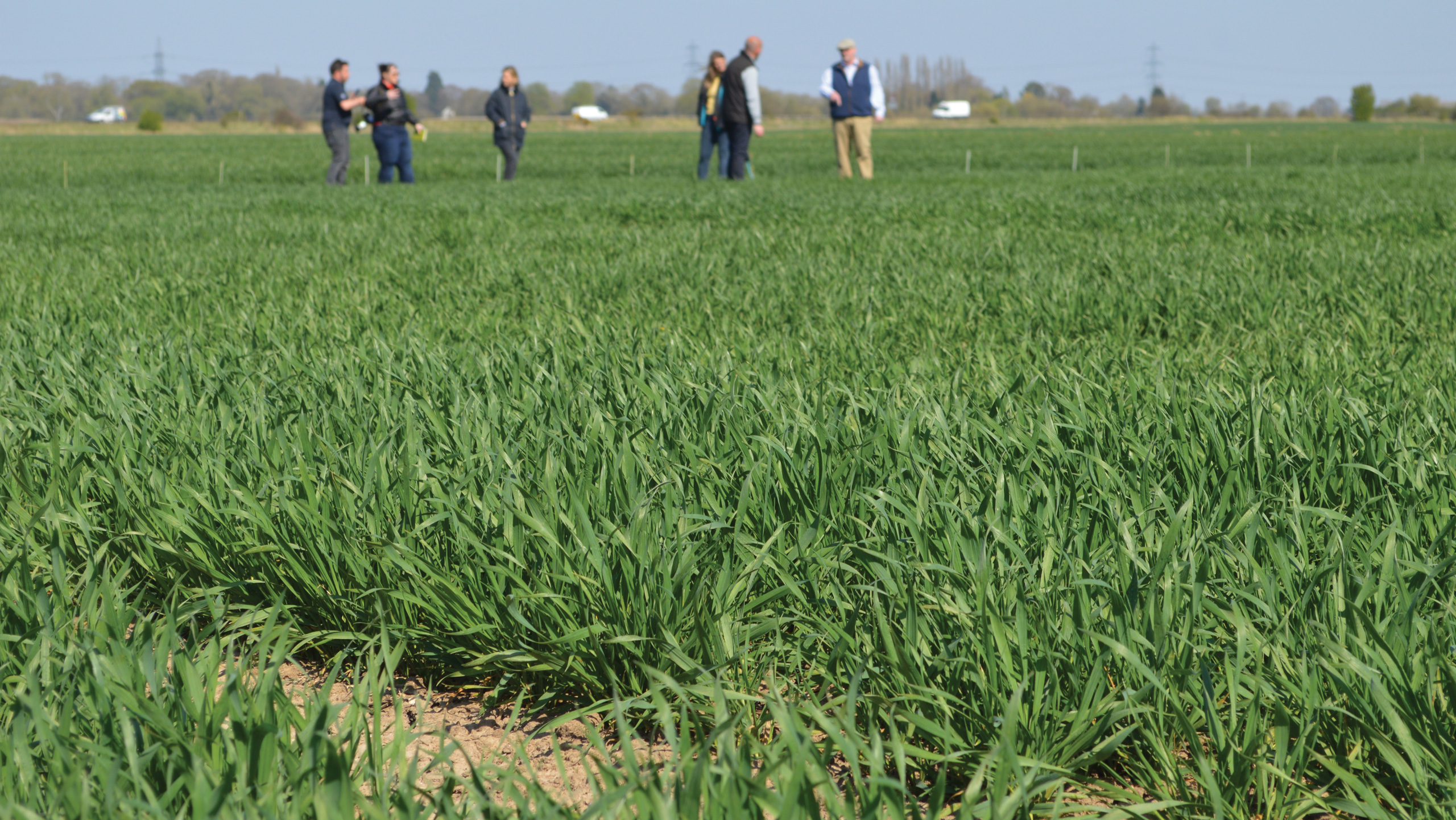
Trial site in Norfolk © David Jones
Yellow rust was difficult to identify in north-west Norfolk in this rust “hot spot” around the Wash, as late-drilled winter wheat crops did not have sufficient leaves for the disease to gain a foothold.
The Crop Doctor trial site, only a few miles from the sea, was showing plenty of septoria on the dry, older leaves, but no yellow rust in the current dry and breezy conditions, although small spots of brown rust were picked up in the varieties Crusoe and Extase.
Aoife O’Driscoll, senior specialist in plant pathology at crop consultant Niab, warns that growers need to start early to keep on top of rusts and should consider variety choice, the history of the field and visible signs of disease before considering a spray.
“The wheat crop here is small and dry with no canopy for rust to take hold, but yellow rust could come in the next few weeks depending on the weather,” she says.
The T0 spray in late March/early April is a rust decision and could be missed out in a low-risk situation, but the T1 timing in late April is very important to protect leaf three if rust is coming in and wetter weather encourages septoria.
“The disease risk is currently modest to low, but T1 treatments need to take a good broad-spectrum approach to protect against septoria, rusts, eyespot and mildew,” she adds.

Alice O’Driscoll of Niab, and Darren Adkins of Bayer © David Jones
The trial site is on the farm of father and son Clive and Andrew Melton at Pear Tree Farm, Walpole Highway, a few miles south west of King’s Lynn, on silty clay loamy soils where septoria is a constant concern and rusts can be a problem.
The trial plots were drilled on 8 November with the surrounding field of the new variety Beowulf sown earlier on 6 October.
“Septoria is our main worry, while yellow rust will always be there and brown rust was particularly bad last year on the Crusoe,” says Andrew.
Andrew had already applied a T0 of the azole tebuconazole with a strobilurin to the variety Crusoe on the farm because of its susceptibility to brown rust – scoring only a 3 – while for Dawsum, with a 9 for yellow rust and a 7 for brown rust, the T0 spray was missed out.
The AHDB’s Recommended List scores disease resistance for varieties on a 1-9 scale with 1 being very susceptible and 9 showing good resistance.
Andrew’s action matched Aoife’s advice of a tebuconazole/strobilurin spray at T0 for high-risk varieties, especially if there are rust pustules present. Most experts believe that in the current dry weather there is unlikely to be any early serious infection of brown rust, which thrives in the sort of warm and moist conditions seen in 2024.
Aoife points out that growers have two new SDHIs this year – Iblon and Adepidyn – plus Inatreq with its different site of action, and a relatively new azole, Revysol, to protect against disease through the T1 and T2 stage, with a broad-spectrum approach at T1 followed by a more septoria-focused one at T2.
Darren Adkins, Bayer’s manager for the site, says the disease risk currently is modest to low with septoria seen on the lower leaves in the trial plots and the surrounding crop of Beowulf, but it is being kept in check by the current dry weather.
“Growers should be looking at a T1 spray to cover a number of disease bases and this needs to be robust enough to cover the crop for three weeks until the T2 spray,” he says.
At the T2 flag leaf stage in late May, he says growers will know more about the disease pressure in their crops and can tailor a spray accordingly, and this will likely have a focus on septoria.
- Farmers Weekly visited all three of Bayer’s Crop Doctor sites, in Herefordshire, North Yorkshire and north-west Norfolk, in the first few days of April.

